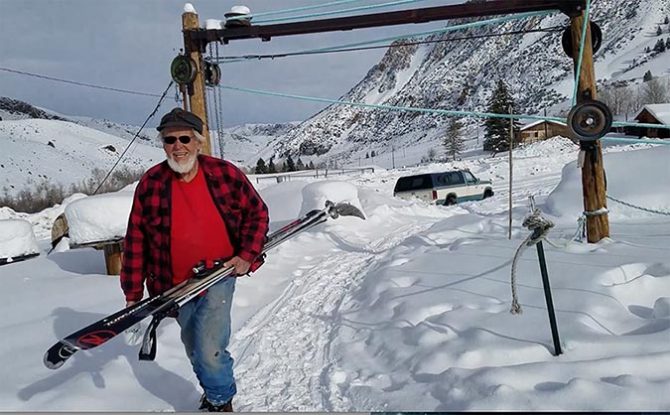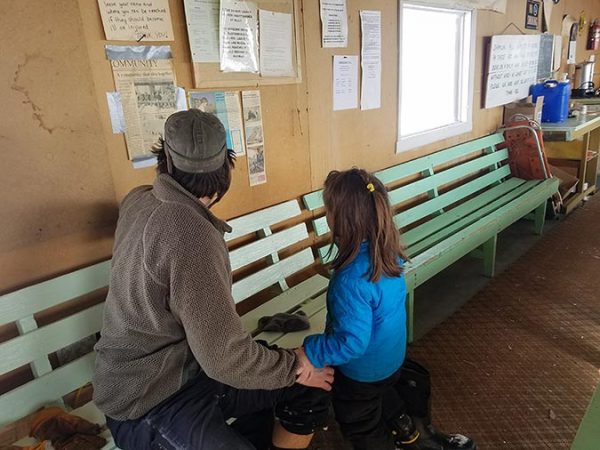
Small, one-rope tow ski hill like this in Challis, Idaho is what makes riding snow great.
His directions seemed easy enough: turn left on Main Street and keep going for about four miles. What he forgot to mention was the mind-blowing paradigm shift that occurs upon rounding the corner into the parking lot.
I met Bryan Parker on my birthday, just over a week ago. Having been removed from human contact for the better part of two days on a backcountry mission in Idaho I decided to pull into the River of No Return Brewery in Challis to toast myself and another year around the sun. Whilst immersed in scrolling the routine Facebook messages from far too many people I had lost touch with, yet who still cared enough to spend five seconds posting on my wall, Bryan struck up a conversation.
“You live here in Challis?” he asked.
“No, I’m just passing through looking for some new ski touring routes,” I said as I snapped out of the screen trance, embarrassed that I was so glued to the phone I didn’t greet him as he sat.
“Skiing, huh? Don’t say too much,” he murmured with a grin. It was the type of kidding that people imply when they are actually serious but don’t want to let on the degree of their seriousness. “You should come to Chipmunk.”
“Chipmunk?”
“Yeah, it’s our ski club. We’ve got a rope tow that’s the biggest in the US. You should come out. We open at 11.”
He had me at ski hill, but his persuasive enthusiasm only got me more intrigued. Over the next hour he told me with glowing eyes about his passion project: a community-owned property of 30 acres in the Challis, Idaho hinterland. Backing up to the edge of the Frank Church Wilderness, the Chipmunk Ski Hill was the only uphill access around within a two-hour drive. It’s one of many small, locally-run ski hills that are little more than glorified rope tows around the country, often powered by old car engines. Because at these spots, it’s all about riding snow. And they’re key to keeping the everyman involved in the sport
The surrounding mountains around Chipmunk had terrain that would make most backcountry riders wet themselves (you didn’t hear that from me), but this small hill was of a different sort. It was born from a lineage of ski hills that are fading fast; losing traction to the big resorts that lure people from all around with temptations of fast chairlifts, massive lodges, and the latest gear for that perfect profile photo from the top of the tram.
I’m not here to hate on the mega resorts and the people who love them. We’ve all been there and they have their time and place (I’ve experienced some of the best days of my life at mega resorts). I simply want to illustrate how ski clubs like Chipmunk serve as guardians of purity in snow sports. Experiencing a place like this, regardless of the terrain or conditions (or lack thereof), is necessary to understand where the sport has come from.
You see, the past few decades have been a tough time for skiers and even snowboarders who came of age amidst the turmoil. Since the 1990s, we’ve seen a mass consolidation and expansion of most resorts in North America, resulting in an overwhelming amount of excess in the likes of expensive lift tickets, overpriced meals, grumpy locals, and a tourist population where skiing and riding is a nice-to-have addition to their vacation from the so-called “real world”.
But amongst all of that, there are still ski hills that don’t subscribe to that narrative. They exist solely to create a venue to slide down snow, providing an initiation to a lifestyle where the barrier to entry is not preventative for so many people. They pop up all over the place; usually in small towns far from a big resort with the potential to lure others away.
Our case study of Chipmunk fits that bill. Having been in operation since the 1960s, you truly do feel as though you have stepped back in time. Even the four-mile approach from the town (population 1,000) reminded me of the establishing shots of an old Western movie: run down barns, deer, horses, falcons, sagebrush popping up through the snow; until I see the sign letting me know I’m not lost.
A couple more turns in the road and I saw the entire property in one frame of view. The parking lot had two cars and a giant spool of rope, the replacement for when the old one finally frays away to oblivion. Bryan was outside with his five-year-old daughter, enjoying the sun and getting ready for the day. With a warm greeting, he welcomed me into the lodge and I stepped back in time. A giant wood stove, heavily stoked, provided warmth to the space. The other kind of warmth radiated from the walls with old news clippings, photographs, and the coffee-stained rate sheet stapled to the bulletin board.
Eventually, we made our way to the rope tow. There wasn’t exactly a rush to get first tracks against Parker, his 5-year-old daughter, and an older local who had never skied powder before. No matter the size of the hill or the angle of the pitch, riding powder is in its own category of fun. The child within gets a chance at free expression on a 3D canvas.

Generations of small-town skiers and snowboarders have learned on the town mountain.
Chipmunk isn’t the only small hill around (there’s at least three more in Idaho alone). Almost anywhere with snow you’ll likely find locals who’ve set up rope tows for riding, with ultra-cheap pricing (try a $5 lift ticket) or simply a cheap club membership. I would hope that the care and appreciation in each location would be similar to Parker’s, and I imagine the snow stoke makes that so.
For the sake of the sport’s soul, let’s hope that Chipmunk and its kin stays around for a while. Otherwise, local kids and old-timers alike won’t have the necessary accessibility to the sport. Skiing and snowboarding are already sports of the elite, but hills like this bring the game to anyone willing. Let’s win one for the everybody’s–for every dollar spent on a day ticket at one of the big names, spend a quarter of that amount on your local ski club and see what happens. The five or ten bucks is worth it just for the throwback feel, let alone the empty terrain.

